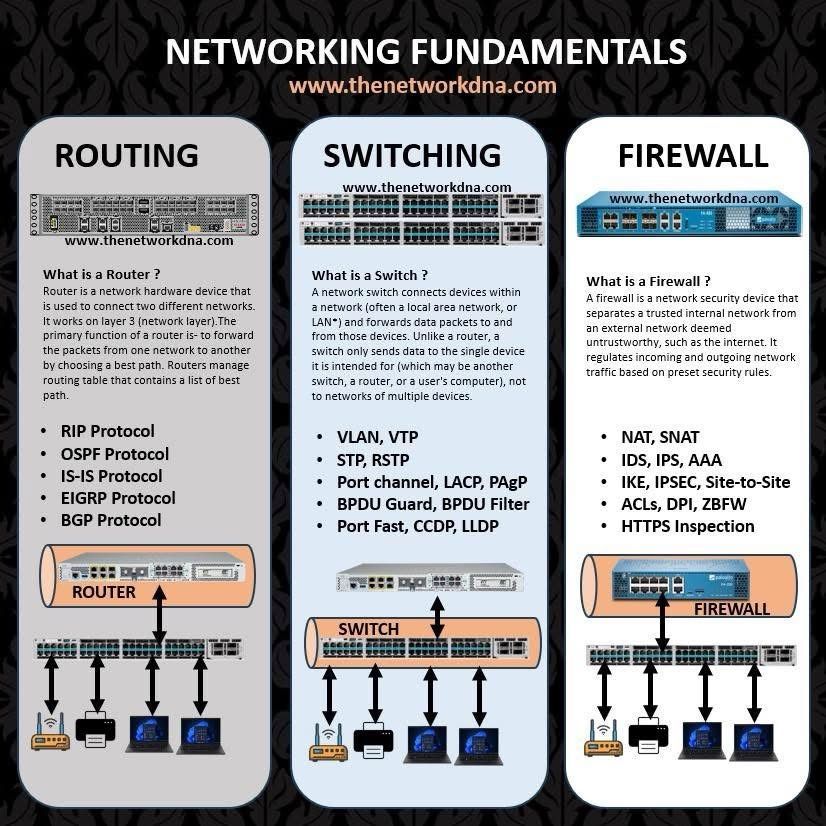In a world where more than 300,000 emails are sent every second, 7 million Google searches are performed, and hundreds of thousands of WhatsApp messages are sent, few consider the silent machinery that makes this global communication possible: network infrastructure.
Behind every click, video call, or online purchase, there are three essential players ensuring data reaches its destination quickly and securely: the router, the switch, and the firewall. Three pillars forming the foundation of the Internet and modern networks.
The router: the cartographer of the Internet
The router is one of the most significant devices in the history of telecommunications. It originated in the 1980s as an evolution of the old gateways that connected local networks. Today, its role remains the same: deciding the path of data.
- How it works: operates on the Layer 3 of the OSI model (network). Its primary task is to choose the best route for data to reach its destination, using routing protocols like OSPF, BGP, EIGRP, IS-IS, or RIP.
- Everyday example: when a user in Madrid accesses a server in California, their provider’s router selects the optimal path, avoiding congestion or broken links.
- Importance in the Internet: without routers, the “network of networks” wouldn’t exist. Each hop a data packet takes in the network passes from one router to another until it reaches its destination.
Fun fact: the BGP (Border Gateway Protocol) is what holds the entire Internet together. If it fails or is misconfigured, massive outages can occur, like in 2021, when Facebook, Instagram, and WhatsApp were offline for over six hours.
The switch: the orchestra conductor of the local network
While the router connects networks, the switch manages traffic within the same network, typically in an office, data center, or a modern home.
- How it works: mainly operates on the Layer 2 of the OSI model (data link), although current switches include Layer 3 functionalities. Unlike old hubs, which broadcast data to all ports, switches send data only to the correct device.
- Key benefit: this intelligence prevents data collisions, increases speed, and allows dozens or hundreds of devices to operate simultaneously without saturating the network.
- Advanced features: enable creation of VLANs (virtual networks), configure port channels (LACP/PAgP) to increase link capacity, and implement redundancy protocols like STP (Spanning Tree Protocol) to prevent network loops that could cause collapse.
Real-world example: in a hospital, switches handle data traffic from medical equipment, nursing stations, surveillance systems, and administrative networks, ensuring each flow has priority based on its importance.
The firewall: the security guardian
In a context where cyberattacks grow by 30% annually, the firewall has become the most important barrier against intrusions, malware, and unauthorized access.
- How it works: acts as a border between trusted networks (internal) and external networks (Internet). Its mission is to filter traffic based on predefined rules.
- Protection types: modern firewalls no longer just filter packets. They incorporate IDS/IPS (intrusion detection and prevention systems), VPNs (IPSec/IKE), NAT/SNAT for IP address translation, ACLs (access control lists), DPI (Deep Packet Inspection), and HTTPS traffic analysis.
- Moving toward Zero Trust: in increasingly distributed corporate environments, firewalls are integrated into Zero Trust architectures, where no access is considered valid without verification.
Everyday example: when an employee connects remotely to their company’s network, the firewall authenticates credentials, encrypts the connection with a VPN, and only then grants access to internal resources.
Why are these three pillars so important?
Routers, switches, and firewalls perform complementary functions:
- Routers enable global communication.
- Switches organize local traffic efficiently.
- Firewalls protect against external threats and control access.
If any of them fails, the consequences can be devastating:
- No routers, no Internet.
- No switches, chaotic and slow local networks.
- No firewalls, vulnerable to cyberattacks in seconds.
A brief history
- 1974: Vint Cerf and Bob Kahn first describe the concept of “gateway,” precursor to the router.
- 1981: Cisco Systems manufactures its first commercial router.
- 1990s: switches replace hubs as the standard in corporate networks.
- 2000s: firewalls evolve from simple packet filters to comprehensive security systems.
- 2020s: concepts like SD-WAN, Next-Generation Firewalls (NGFW), and software-defined switches emerge, enabling dynamic and automated network management.
Looking to the future
The growth of artificial intelligence, 5G, edge computing, and the Internet of Things (IoT) is exponentially increasing data traffic, posing new challenges:
- Routers will need to handle more dynamic routing in distributed environments.
- Switches will incorporate more intelligence to prioritize critical traffic, like that from autonomous vehicles or remote surgeries.
- Firewalls will leverage AI to detect attacks in real-time, even anticipating threats before they happen.
Moreover, the rise of cloud and hybrid architectures is forcing these devices to reinvent themselves as virtualized services. Today, there are virtual firewalls, routers, and switches deployed in the cloud, capable of protecting and managing traffic without physical hardware dependency.
In summary
Although invisible to most users, routers, switches, and firewalls are the true guardians of the digital world. Without them, global communication, remote work, e-commerce, and online entertainment would be impossible.
Next time a video call goes smoothly or an online payment is secure, remember that an invisible orchestration of devices tirelessly works behind the scenes to keep everything flowing.
Frequently Asked Questions (FAQ)
1. Can I have a router, switch, and firewall in a single device?
Yes, many modern home routers include basic switch and firewall functions. However, in enterprise settings, they are usually separated to ensure higher performance and security.
2. What’s the difference between a traditional firewall and a next-generation firewall (NGFW)?
Traditional firewalls filter traffic based on simple rules (IP, ports). NGFWs incorporate deep packet inspection (DPI), advanced threat detection, application control, and user-based policies.
3. How does a router influence Internet speed?
A router affects speed by managing routes and protocols, but the overall bandwidth depends on your plan. A poor-quality router can create bottlenecks even with a good connection.
4. Can switches and routers be used in home networks?
Absolutely. In homes with many connected devices, a switch can expand ports and organize traffic. The router is essential for connecting to the Internet, and firewalls are increasingly necessary due to rising cyber threats.

via: LinkedIn

